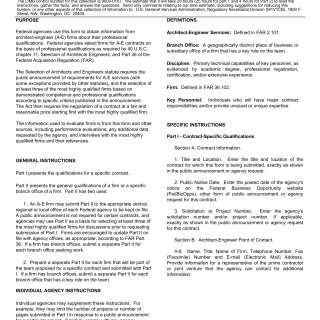SF 330. Architect-Engineer Qualifications
The SF 330 form is also known as the "Architect-Engineer Qualifications" form. It is a standard form used by the United States government to collect information from architectural and engineering firms who are interested in bidding on government projects.
The purpose of the SF 330 form is to provide the government with information about the qualifications and experience of the architectural or engineering firm, as well as information about the specific personnel who will be working on the project. This form is used to evaluate the technical abilities of the firm and its personnel, and to determine whether they are qualified to undertake the project.
The SF 330 form consists of several parts, including:
- Part I: General Information - This part includes basic information about the firm, such as its name, address, and type of ownership.
- Part II: Qualifications - This part asks for information about the firm's qualifications, experience, and capabilities.
- Part III: Experience and Related Projects - This part asks for detailed information about the firm's experience with similar projects and related work.
- Part IV: Personnel - This part asks for information about the personnel who will be working on the project, including their education, experience, and qualifications.
The most important fields on the SF 330 form are typically those in Part II and Part III, as they provide the government with information about the firm's qualifications and experience.
The SF 330 form is typically compiled by architectural and engineering firms who are interested in bidding on government projects. The parties to the document are the firm that is submitting the form and the government agency that is evaluating the firm's qualifications.
When compiling the SF 330 form, it is important to provide detailed and accurate information about the firm's qualifications, experience, and capabilities. The firm should also ensure that the personnel listed on the form are qualified and experienced in the relevant areas.
The advantages of the SF 330 form are that it provides a standardized format for collecting information from architectural and engineering firms, which makes it easier for the government to evaluate the firms and select the most qualified one for the project.
Some problems that can arise when filling out the SF 330 form include providing inaccurate or incomplete information, which can lead to the firm being disqualified from the bidding process.
Related forms to the SF 330 include the SF 254 and SF 255 forms, which are used for architectural and engineering services for smaller projects. An alternative form to the SF 330 is the Standard Form 1442, which is used for bidding on government contracts.
The SF 330 form is typically submitted to the government agency that is soliciting bids for the project. The form is usually submitted electronically through the agency's procurement system. The government agency will keep the form on file as part of the bidding process.

